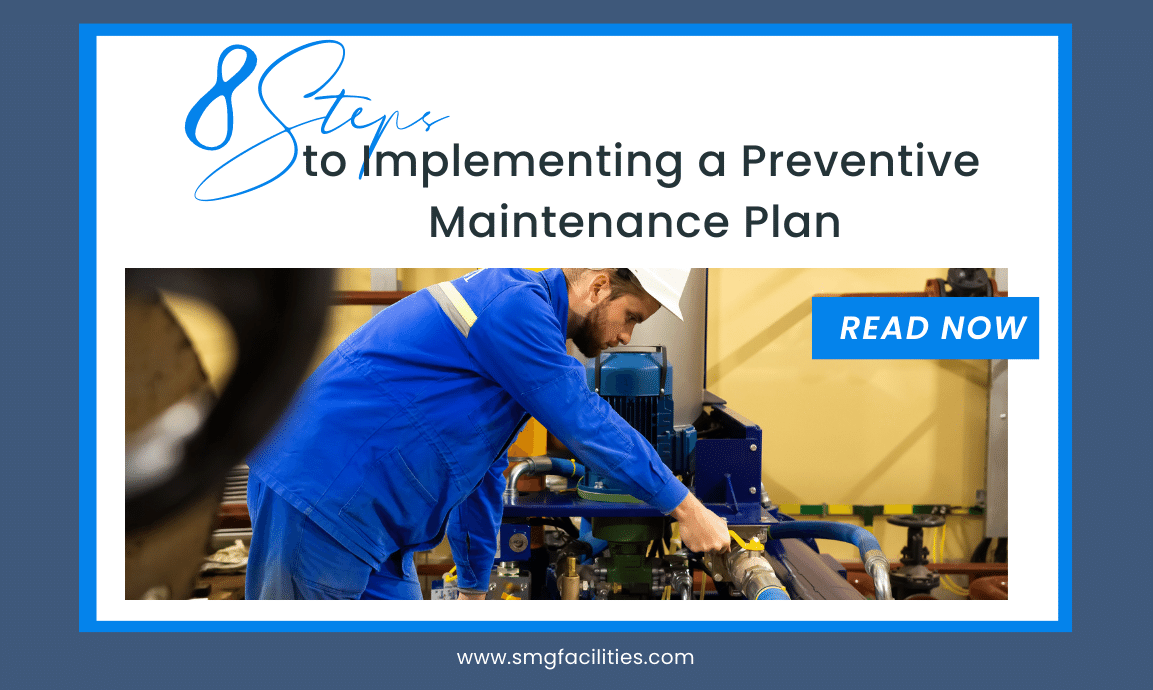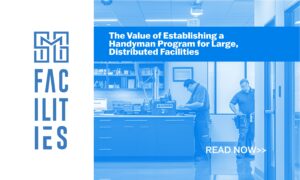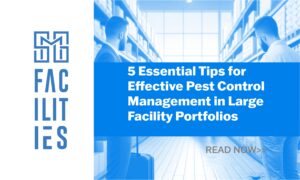Preventive maintenance seems like such a sensible thing. It has so many positives going for it. Yet why does it always take a back seat? Well, human beings often get caught up in the here and now and forget about the future and what it can bring. Without preventive maintenance, the future can bring a machine breaking down in the middle of a very important shift or an AC unit wheezing to a stop during a 100-degree day. That’s why it is time for facilities managers to move away from the dark ages of reactive maintenance and bask in the reduced costs, fewer headaches, and increasingly valuable time that preventive maintenance can offer.
This blog defines preventive maintenance, what a PM plan should include, a step-by-step guide on how to create a preventive maintenance plan, its return on investment, and how outsourcing can help make your plan even easier to attain.
What is a Preventive Maintenance Program?
A Preventive Maintenance (PM) program is a regularly adhered-to plan that schedules upkeep on assets to cut down on the likelihood of breakdowns. In other words, it’s a way to catch equipment failures before they cost a company serious downtime and result in expensive repairs. No one wants the HVAC unit to fail during the coldest day of the year, so periodic maintenance checks can help ensure that doesn’t happen. But preventive maintenance isn’t just about when big equipment needs repairs. It includes scheduled cleaning or lubricating and changing filters at regular intervals stated in the equipment manuals.
What Should a Preventive Maintenance Plan Include?
A preventive maintenance plan should have three broad phases: scheduling, performing, and reviewing.
- Scheduling: This phase is about ensuring maintenance is slated for a specific time or day and that everything is set for that to happen.
- Performing: The actual maintenance and equipment assessments occur in this phase.
- Reviewing: Here, you can analyze the state of the equipment and discuss longer-term concerns that warrant a closer watch over the equipment or the need to schedule more frequent maintenance or, perhaps, look into a replacement.
How to Create a Preventative Maintenance Plan in Eight Steps
For a preventative maintenance program to work and be worth the time and effort, it must be clear what needs to be done and when, and everyone must be on board and prepared for it. Here is an eight-step guideline for setting up and following through on a successful preventative maintenance program.
Step 1. Identify and Prioritize Your Goals
It all starts when you know what you want your preventative maintenance program to do. Write down the reasons for doing it. They can be anything from preemptively trying to keep costly breakdowns from occurring to increasing efficiency, boosting productivity and profitability, or just making sure everything looks clean and impressive if a customer, senior team member, or investor walks in. Once you have identified the goals, you must list them in order of importance so that your biggest concerns or worries are the first things that garner your attention and execution. Lists can often be overwhelming, so ensuring the most prudent and in-need items are placed at the top is essential.
Step 2: Know Your KPIs and Continually Assess Them
For preventative maintenance to succeed, you need to have attainable targets to reach. There are myriad maintenance metrics to help you — overall equipment effectiveness, the mean time between failures, planned maintenance percentage, and preventive maintenance compliance, to name a few. There is software (for example, Computerized Maintenance Management Systems) that can help calculate these metrics and provide the “actionable” data you need to determine the key performance indicators (KPIs). Remember, the data and KPIs are only beneficial if understood, acted upon, and scrutinized regularly. Consistent procedures need to be followed closely and updated, if need be, to meet your goals.
Step 3: Bring Stakeholders Onboard
A preventive maintenance program does not survive on just one person alone. It needs to have everyone aboard. That means the technician who inputs the data, the facility team member(s) who reads the data, the maintenance manager, and even the people who use or supervise that particular piece of equipment. They should be included in all goals, needs, and resource discussions. Their input can sometimes identify a concern that was not considered in the planning and bring about a more positive result. Also, it makes them see they are important to the overall success of the preventive maintenance program and the company in general.
Step 4: Choosing and Using the Right Technology
Technology makes life a lot easier when it comes to preventive maintenance. With the right software, mundane preventive maintenance tasks — scheduling, inventory maintenance management, reporting, and organizing work orders — can be handed over to technology. But it is vital to have the right technology for a PM program, one that includes aspects such as:
- The team’s skill set
- Your budget
- Your asset capabilities
- Team preference
- Data Validity
- Data security
It must also be easy to use and provide supply data so that all on your team can digest it easily.
Step 5: Make Sure Your PM “Triggers” are Accurate
Triggers alert team members that an asset requires maintenance and are a key step in constructing a preventive maintenance plan. Factors in determining the timing of a trigger include:
- The manufacturer’s recommended guidelines.
- The asset’s performance history.
- How critical the asset is to the operations of the facility as well as the guest.
- Repair cost vs. maintenance.
- Where the asset is in its useful life cycle.
Knowing the triggers is a must for all maintenance team members so no task gets overlooked. Automated scheduling and mobile notifications make it easy for team members to keep track.
Step 6: Educating All Concerned
With an established preventive maintenance plan in hand, it’s time to make sure others are fully aware of the plan and prepared. Creating a training strategy that helps team members and relevant service providers get up to speed on the correct equipment maintenance is essential. Everyone should be trained on any new technology as well as any processes and procedures that come with a preventive maintenance shift. These can include prioritizing work orders, devising failure codes, and knowing how to access documents digitally. Those who work in the same facility, department, or on the same piece of equipment can train together.
Step 7: Remaining Diligent and Track Results
It all just doesn’t stop when the maintenance is complete. The only preventive maintenance programs that work are ones that never sleep. Continued asset inspection and analysis of the numbers must be part of the PM plan. Both are needed to ensure the asset continues to perform as it should after the maintenance. That information also helps let you know if the preventive maintenance plan is making an efficient impact. A checklist can help you track KPIs, like the mean time between failures.
Step 8: Fine-Tune Your Plan
Congrats, you have planned, implemented, and analyzed your first preventive maintenance program. Now it’s time to find out how to do it even better. There is rarely a plan that goes 100% perfect. And, remember, you are dealing with so many cogs and wheels that change, in this case, known as wear and tear, is inevitable. So now is the time to fine-tune that program for the next maintenance wave. Are there any gaps to fill? You can add in that asset that didn’t make the initial list. What were the weaknesses and strengths? Data from sensors, work order notes, and digital reports can point those out. Be sure to involve all team members and relevant service providers who were part of the plan so they can see the improvement process.
ROI of Preventive Maintenance Programs
The return on investment or ROI of a preventive maintenance program is often hard to quantify in exact numbers, mainly because it deals with “what could have been” situations. If you stop some breakdown from happening, the cost of what that breakdown would have been can only be estimated. But even evaluating that can still prove to be a hefty sum. One accepted way to get an estimation is to take the original cost of preventative maintenance repair and multiply it by itself to give a ballpark of what a breakdown repair would cost. For example, let’s say something that would have cost $200 to repair as part of a preventive maintenance program goes unchecked and finally stops working—going by this way of estimating, that breakdown would cost $4000. It’s not too difficult to see how high the cost can be if there is a failure to employ a preventive maintenance program.
When to Outsource Preventive Maintenance Programs
Team members can perform some tasks in a preventive maintenance program, but there are many areas in which having an established partner with more knowledge and resources can be extremely helpful. Many companies do not have experts that consistently work on specific pieces of complex machinery, so outsourcing part of a PM program can be the best route. With many of its resources, your outsourcing partner can almost always find the expert that is needed and set up a service inspection that will be much more thorough. That expert is also much more likely to be able to quickly track down any resources if parts need to be replaced.
With all the hats that facilities managers have to wear, it’s no wonder they sometimes lose their hair. This is also where an experienced outsourcing provider can come in handy. The provider can pick up any preventive maintenance tasks and schedule inspections to help lighten the facility manager’s load and give them peace of mind that a specialist will handle the service.
SMG Can Manage Your Preventive Maintenance Needs
With all the information provided above, a clear path has been laid out for facilities managers to forge a preventive maintenance program. This blog has also shown that a PM program not only saves a company from unexpected costs in the future if a significant piece of equipment breaks down, but it can also provide a way to ensure all assets stay in tip-top shape. A viable preventive maintenance program takes time to plan, evaluate and implement. It can often leave a facilities manager’s head spinning. That’s where outsourcing can come into play. SMG Facilities, an integrated facilities management company, can be the right partner to keep your world in balance and maintain your company’s brand. Our single-source accountability can streamline your operations, reduce maintenance costs, extend critical equipment’s asset life, and ensure minimal disruption to your facilities. Check out our website and partner with us today.

